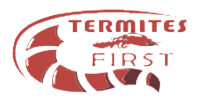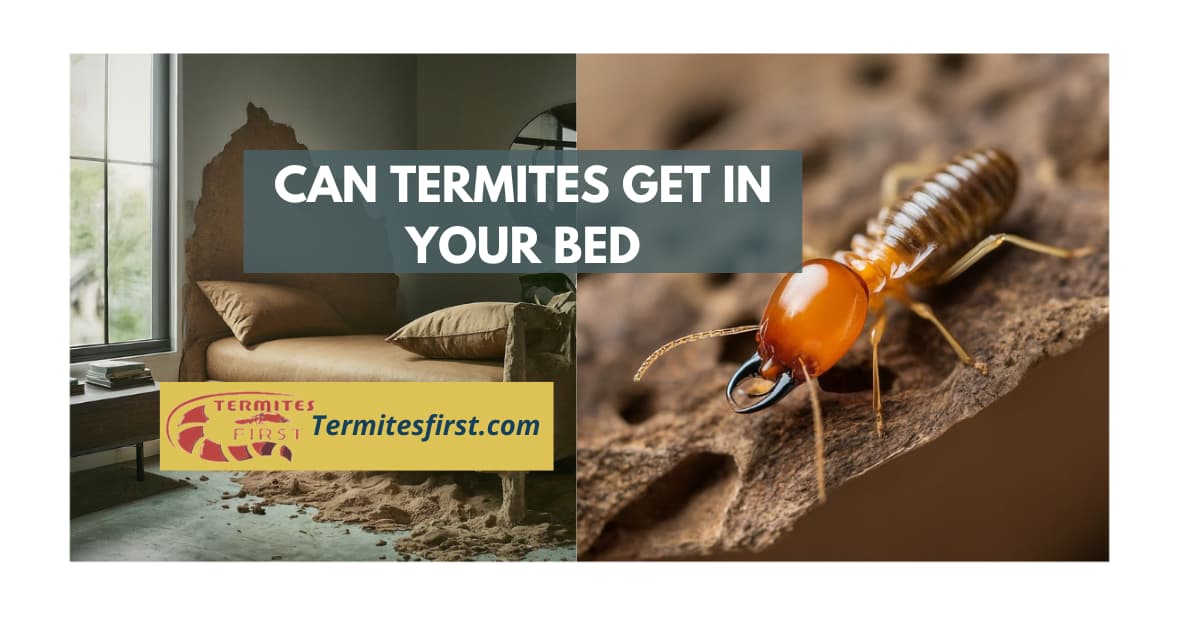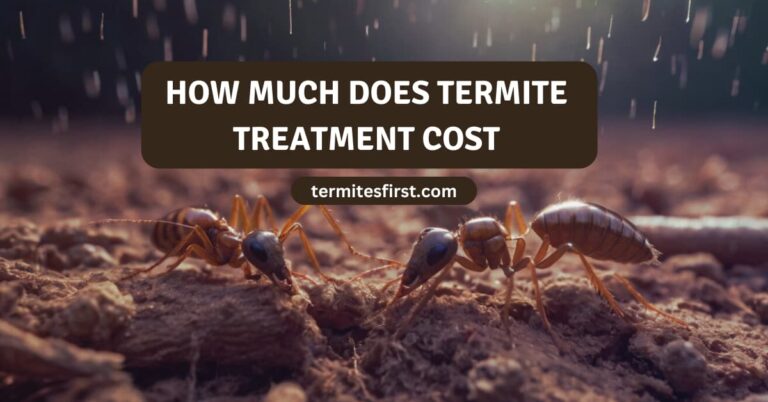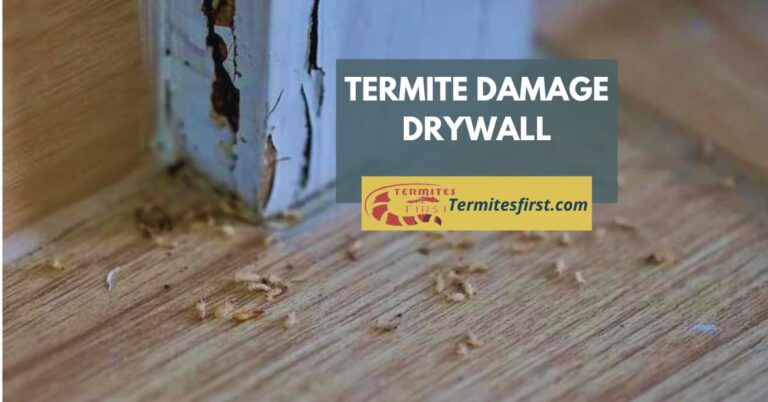Can Termites Get in Your Bed? Preventing Infestation and Damage
Curious about”can termites get in your bed“? The answer may surprise you. Termites are known for their voracious appetite for wood, but they can also infiltrate other areas of your home, including the bedroom. In this post, we’ll explore the unsettling possibility of termites making their way into your sleeping space and provide practical insights on prevention and detection.
Termites in the bedroom pose potential risks to both property and health. It is essential to comprehend these pests’ methods to protect your house. Stay tuned as we delve into the signs to watch out for and effective measures to keep these unwelcome guests at bay.
Can Termites Infest Your Bed
Termites are social insects that reside in communities. They communicate through pheromones and vibrations. Their hierarchical structure consists of different castes, such as workers, soldiers, and the reproductive caste.
These microscopic organisms have the ability to infiltrate several areas of a house, including the bedroom. While they may not infest your actual mattress, they can certainly target wooden bed frames or headboards if they are made from cellulose materials.
Identifying Infestation Signs
To determine whether termites have invaded your sleeping space, keep an eye out for specific signs. Look for mud tubes on foundations or walls; termites use these as safe routes to get from their nest to the food supply.Wings thrown out close to windows or other sources of light may be a sign of an infestation. Termites shed their wings when they meet a partner and swarm to build new colonies.If you tap on wooden surfaces around your bed and notice a hollow sound instead of the usual solid one, this could be indicative of termite damage within the wood’s interior.
Dealing with Infestations
For practical treatment choices, it’s imperative to speak with a reputable pest control business. These experts have access to specialized knowledge and tools necessary for eradicating termites safely and effectively from living spaces.
In some cases where traditional treatments prove ineffective due to extensive infestation levels or other factors like accessibility issues, fumigation might be considered as a viable option. Fumigation involves sealing off the affected area before introducing gas designed to eliminate all pests present within it.
Preventative Strategies
Preventing termite invasions is key to safeguarding not only your sleep environment but also other areas of your home.
• Remove any wood debris or cellulose materials around your property that could attract termites seeking sustenance.
• Ensure proper ventilation and drainage throughout indoor spaces by addressing any moisture buildup concerns; this helps deter potential termite activity since these pests thrive in damp conditions.
Understanding Termite Behavior
Feeding Preferences
The main food source for termites is cellulose-based materials, such as wood. They can also consume paper, cardboard, and fabric containing plant fibers. For instance, if your bed frame or headboard is made of wood, termites could potentially infest it. Some species of termites may even attack plastic or rubber materials if those items contain cellulose.
Nesting Habits
To preserve the moisture levels necessary for their life, subterranean termites construct their nests underground. Drywood termites create nests within the wood they infest, making them particularly challenging to detect without professional inspection. Dampwood termites prefer moist environments like decaying logs but are less likely to be found in indoor structures due to the drier conditions typically maintained inside homes.
It’s important to note that while finding termites in your bed is unlikely due to its dry environment and lack of cellulose-rich materials (unless it’s specifically wooden), understanding these nesting habits can help homeowners identify potential areas where termite activity might occur within their homes.
Swarm Patterns
Swarms of termites typically happen in the spring when reproducing individuals depart from established colonies in search of new areas to start new colonies. Swarming behavior indicates a mature termite colony nearby and should prompt immediate action from homeowners who suspect an infestation.
Swarms are attracted to light sources and may be found near windows as they attempt to exit the building through openings leading outside. If you notice swarming insects around your home’s windows during springtime, especially if they resemble flying ants with straight antennae rather than bent ones characteristic of most ant species, it’s crucial to have a professional pest inspection conducted promptly.
Identifying Signs of Termite Infestation in Beds
Visual Indicators
Termites can infest various wooden structures, including beds. Look for small holes or tunnels in the wooden components of the bed frame, headboard, or footboard. These tiny openings are often a clear sign of termite activity. Look for any mud tubes near the bed on the foundation or walls. Termites make these tubes to carry moisture from their nest to their food supply.
Moreover, keep an eye out for termite droppings, also known as frass. If you notice small pellets resembling sawdust near your bed or other wooden furniture, it could indicate a termite infestation. The kind of wood that termites are eating and their species might affect the color of the frass.
Recognizing Droppings
When inspecting your bed for signs of termites, pay close attention to any presence of termite droppings (frass). These droppings typically resemble small pellets or grains similar to sawdust and may be found near areas where termites have been active within the bed’s structure.
Frass is often located near termite galleries within damaged wood or around areas that have been affected by termite activity. It’s crucial to recognize that different types of termites may produce varying colors and sizes of frass depending on their species and diet.
Wood Damage Symptoms
In addition to visual indicators like holes and tunnels in wooden structures, there are specific symptoms related to wood damage caused by termites in beds. Keep an eye out for sagging floors or ceilings around your bed area; this might be indicative of structural damage resulting from termite infestation.
Furthermore, if you come across hollowed-out sections within your bed frame with a honeycomb-like pattern, it’s likely due to termite activity inside these wooden components. Another telltale sign is discovering mud tubes inside these structures; this indicates ongoing termite infestation within your bedding materials.
Identifying Termite Damage in Beds
Signs of Infestation
Termites can indeed get into your bed, and identifying the signs of their presence is crucial to prevent future infestations. To find any signs of termites in your bed, you must conduct routine termite inspections. Look out for damaged wood and mattresses as common indicators of a termite colony residing within your bed frame.
Termite behavior often involves consuming cellulose-based materials, such as wood and fabrics found in beds. If you notice hollow-sounding or damaged wooden components in the bed frame, it could be due to termite activity. If there are unexplained holes or sagging areas on the mattress, this might also signal a termite infestation.
Effective Solutions
Upon detecting signs of termites in your bed, seeking professional help from a pest control company is crucial for effective solutions. Expert pest control companies have the knowledge and resources necessary to successfully remove termites from your bed.
Treating the existing infestation of termites in beds is crucial, but so is taking precautions to keep it from happening again. This can include treating the entire bedroom area for pests and ensuring that all potential entry points for termites are sealed off.

Preventing Termites from Entering Your Bed
Protective Measures
To safeguard your bed and other wooden surfaces, consider applying termite-resistant coatings or treatments. When embarking on construction projects, opt for pressure-treated lumber to deter termite infestation. You can also install physical barriers such as metal screens or sand barriers around your home’s perimeter to prevent termites from gaining access.
The application of termite-resistant coatings is crucial. For instance, you can use a borate-based product that effectively repels termites without posing any harm to humans or pets. Moreover, pressure-treated lumber contains chemicals that make it unappealing and resistant to termite attacks.
Self-inspections play a vital role in identifying potential vulnerabilities in your home. Homeowners may quickly remedy any issues before they worsen by regularly inspecting their property for signs of termite activity.
Regular Inspections
Scheduling annual termite inspections by professional pest control companies is essential for early detection and treatment of infestations. These inspections enable experts to identify potential entry points and vulnerable areas within the structure of your home.
Conducting periodic self-inspections complements professional assessments by allowing homeowners to stay vigilant about any signs of termite activity in their homes. This proactive approach empowers individuals with the knowledge needed to take immediate action if they notice any warning signs.
Promptly addressing moisture issues in your home is imperative for preventing termite attraction and infestation. Moisture-laden environments are highly attractive to termites; therefore, ensuring proper ventilation and addressing leaks promptly are essential steps in mitigating this risk.
Environmental Adjustments
Reducing moisture levels in crawl spaces and basements through proper ventilation helps create an environment less conducive to termites’ survival. By eliminating excess moisture, homeowners can significantly reduce the likelihood of attracting these destructive pests into their living spaces. Trimming vegetation away from the foundation serves as a preventive measure against providing direct access points for termites into homes
Recognizing Termite Droppings in Beds
Frass Identification
Termite droppings, also known as frass, can be distinguished from other insect excrement. They have a granular appearance and may contain fecal pellets or remnants of chewed wood. Professional pest inspectors are skilled at accurately identifying frass and determining its source.For instance, if you notice tiny, grainy particles on your bed that resemble sawdust or coffee grounds, it could indicate the presence of termites. These droppings might also appear near the headboard or underneath the mattress.
Dropping Patterns
Termites often drop their frass near their feeding sites, which means they may accumulate in piles or form small mounds beneath infested areas. Understanding dropping patterns can help locate termite colonies within a structure.
For example, if you find concentrated piles of what looks like sawdust around wooden furniture legs or near cracks and crevices in your bedroom, there’s a possibility that termites have infested those areas.
Differentiating Termites from Other Pests in Beds
Physical Differences
Worker termites are pale, soft-bodied, and blind. They are in charge of acquiring food and providing meals for the colony’s other members. In contrast, soldiers have larger mandibles and heads to defend the colony from predators and ants. Last but not least, compared to other castes, reproductive termites are darker in color and have wings. These distinguishing physical characteristics can be crucial when identifying a potential termite infestation.
For example, if you notice small insects with creamy white bodies scurrying around your bed or near it, they could likely be worker termites searching for cellulose-based materials to feed on.
Behavioral Clues
Understanding termite behavior can also help differentiate them from other pests that may infiltrate your bed space. Worker termites constantly forage for food sources to sustain their colony’s nutritional needs while maintaining their nest’s structure and cleanliness. Soldiers defend the colony against external threats such as ants or predators that might attempt to invade their habitat.
Moreover, reproductive termites participate in swarming behavior during specific times of the year when they establish new colonies elsewhere. If you observe winged insects emerging from your bedding areas or windowsills during certain seasons—especially after rain—it might indicate a potential termite swarm nearby seeking a new place to settle.
Professional Termite Inspection for Beds
Inspection Benefits
To identify termite infestations early on, routine inspections are essential. Early discovery reduces harm and expenses by enabling timely treatment. By guaranteeing your home’s structural integrity, it also offers peace of mind. For instance, if you suspect that there might be termites in your bed, a professional inspection can confirm this and prevent further damage.
Professional pest control companies have specialized knowledge in termite detection and treatment. They use advanced techniques such as thermal imaging and moisture meters to identify even the smallest signs of termite activity. These tools help them locate hidden colonies within walls or furniture, including beds.
Expertise and Techniques
Pest control experts can customize treatment plans based on the specific termite species present in your bed or elsewhere in your home. This is important because different types of termites may require different eradication methods. By identifying the exact species infiltrating your bed, professionals can apply targeted treatments that effectively eliminate the infestation without causing harm to you or damaging your property.
Protecting Your Bed from Termite Damage
Material Choices
The selection of building materials is important. When building or remodeling your bed frame, choose materials that are resistant to termites, including concrete, metal, or plastic. Pressure-treated lumber is another excellent option as it is treated with chemicals that deter termites. It’s essential to avoid using untreated wood or cellulose-based materials in areas prone to termite infestations.
For instance:
• Choosing a bed frame made of metal rather than untreated wood can significantly reduce the risk of termite damage.
• Pressure-treated lumber offers an effective solution for preventing termites from causing harm to your bed.
By selecting termite-resistant building materials and avoiding those susceptible to termite attacks, you can safeguard your bed against potential damage caused by these destructive pests.
Barrier Implementations
Implementing barriers is an effective strategy for protecting your bed from potential termite infestations. To keep termites out of a structure, physical barriers like stainless steel mesh can be erected around the outside. Chemical barriers create a protective zone around buildings, acting as a deterrent against termites seeking entry into the structure.
For example:
• Installing stainless steel mesh around the base of the bed frame can serve as an effective physical barrier against termites.
• Applying chemical barriers around the bedroom area creates a protective shield that deters termites from approaching and damaging the bed frame.
Barrier implementations are valuable preventive measures that help fortify your defenses against unwanted termite intrusions. By combining both physical and chemical barrier methods, you create multiple layers of protection for your bed against potential termite threats.
Eliminating Termites from Your Bed
There are numerous alternatives for treatment. Treating the soil surrounding infected areas with liquid termiticides is one of the most used techniques. Termites are unable to access your bed or any other wooden furniture in your bedroom because of the barrier these chemicals create.
Another effective option is to use termite baits, strategically placing them around the perimeter of your home. These baits attract termites, which then carry the poison back to their colonies, effectively eliminating them over time and preventing any further damage to your bed.
For severe infestations, especially those that have spread throughout the house, fumigation may be necessary. This comprehensive treatment involves sealing off the entire house and releasing a gas that penetrates every nook and cranny, eradicating all termite colonies present.
It’s essential to consider these treatment options when dealing with potential termite infestations in your bedroom, especially if you suspect they may have reached your bed or other furniture made of wood.
Inspecting for Termite Activity in Beds
Active Infestation Signs
Live termites found inside your home indicate an active infestation. These pests may be present in the bed frame, headboard, or even the mattress itself. If you notice live termites in these areas, it’s a clear sign of an ongoing problem that needs immediate attention.
The presence of swarmers or discarded wings near light sources is another indicator of an active colony. Termites that swarm are reproductive insects that leave established colonies to establish new ones. Finding them around your bed or nearby light fixtures suggests that there might be a termite nest within close proximity.
Audible tapping or rustling sounds coming from walls may also indicate termite activity near your bed. While not always audible, some people report hearing faint noises resembling tapping or rustling coming from the walls where termites are actively feeding and tunneling through wood.
Discarded Wings Search
Checking windowsills, light fixtures, and spider webs for discarded termite wings can help determine if there’s termite activity around your bed area. Wings are shed by reproductive termites during swarming season when they leave their original colony to establish new ones.
Finding discarded wings suggests the presence of an active termite colony nearby since these insects typically shed their wings after finding a suitable location for mating and starting a new nest. If you come across these wings around your bedroom or bedding area, it’s crucial to investigate further to identify the extent of the infestation.
Closing Thoughts:
Understanding termite behavior and identifying signs of infestation are crucial in preventing and eliminating these pests from beds. Regular professional inspections and proactive measures to protect against termite damage are essential for maintaining a pest-free sleeping environment. By recognizing termite droppings, differentiating termites from other pests, and inspecting for termite activity, individuals can safeguard their beds effectively.To ensure a bed remains free from termites, it’s imperative to take the necessary steps outlined in this article seriously. By implementing preventive measures and promptly addressing any signs of infestation, individuals can protect their sleep space from potential damage. Stay vigilant and proactive in maintaining a termite-free bed for a peaceful and restful night’s sleep.
Frequently Asked Questions
Yes, termites can infest beds. They are attracted to wood and moisture, making the wooden components of a bed an ideal target for termite infestation.
To prevent termites from entering your bed, you should ensure that your bedroom is not excessively humid or damp. Using termite-resistant materials for your bed frame and regular inspections can help in preventing termite infestation.
Signs of termite infestation in beds include hollow-sounding wood when tapped, discarded wings near windowsills or on bedding, small holes in wooden furniture, and sagging floors or ceilings.
Termite droppings resemble tiny pellets or sawdust and may be found near areas with potential termite activity such as under the mattress or around the bed frame.
Yes, it’s advisable to seek professional inspection if you suspect a termite problem. A trained inspector can accurately assess the situation and recommend appropriate treatment options to address any potential issues with termites in your bed.




